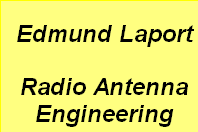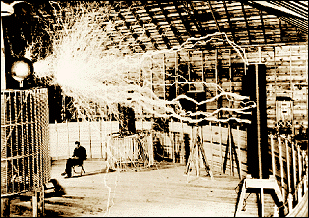


Antentop is FREE e-magazine devoted to Antennas and Amateur Radio an
Special page devoted to
The Underwater Communication System

Custom Search
|
ANTENTOP-
03- 2003, # 004 |
The Underwater Communication
System
|
|
|
|
|
...
a phase displacement of 90 degrees exists
the wave of charge potentials induced by an alternating current
signal upon the water ... and the resulting wave of charge displacements
occurring in the water body between the segments.17
The method of propagation, then, is to periodically alternate electrical charges on the two plates that will launch sinusoidal carrier waves into the medium. When one plate is positive, the other will be negative; then the first will be negative and the second positive. This action, the patent states, will create the sinusoidal waves. In a detailed
analysis of forces involved in this type of transmission Curry
shows that radiators with a capacitance of .0053 microfarads operating
at 100 kHz with signal generator output of 200 volts coupled with
a biasing potential of 1000 volts will produce a force from its
charge displacement of 26,500 dynes.18 On the receiving
side, Curry states that the charge gradient can be expected to
attenuate substantially at even moderate distance from the point
of transmission. As an example he notes that if a signal intensity
of 10,600 dynes at the point of transmission is reduced one billion
times the "standing wave of the signal energy will therefore
be charged with a force differential of 1.06 x 10-5
dynes. Each dipole in his example has a capacitance of .0053 microfarads
with a system capacitance of .00265 microfarads. The voltage developed
in the receiving network is .02 volts. As noted "this is
substantially above the minimum requirements of signal intensity
for the detection of electrical signal energies."19 This
detailed analysis, however, overlooks the important point that
electrostatic waves do not propagate into the medium in the same
way as electromagnetic waves. In an electromagnetic transmission
system, charge is accelerated in an elevated conductor, an antenna,
to launch waves omnidirectionally into
the air. At a receiver, the electromagnetic waves induce a current
in the antenna. The variations in the current are processed by
the detection circuitry to replicate the transmitted information. In electrostatics,
it is not necessary for flux lines to detach from an antenna and
close upon themselves to propagate a wave that is received at
a distant point. The transmitter, in Tesla's plan, oscillates
the earth's charge and the receiver is connected to that same
charge reservoir. Signals are not launched, but exist as pressure
variations in the earth's oscillating electric field. Because
the field already exists at the point of transmission and at the
point of reception, the propagation characteristics are different
from electromagnetic waves. |
In addition to the mode of propagation being different, what travels
between the transmitter and receiver is different. In electromagnetic
transmission waves are sent out that are picked up by the receiving
antenna. These waves induce a current the antenna. In an electrostatic
system a current passes directly between the transmitter and receiver. This current is the same as that which exists in a capacitor, that is,
it is a displacement current. In a standard inductor-capacitor-resistance
circuit, when it is energized and oscillating, it is understood
that the current that passes through the conductors is completed
through the non-conductor of the capacitor's dielectric through
a displacement current. As charge is changed on one plate of the
capacitor, an opposite but equal change in charge is seen on the
other plate of the capacitor. In Tesla's system the transmitter
and receiver act as the capacitor plates and what passes between
them is a displacement current. Displacement current, today, is seen as something of a virtual current,
something different from a "real" or conduction current
that flows through a wire. Tesla, however, understood what is
meant by an electrical current in the same sense as Maxwell -
that "all charge is the residual effect of the polarization
of the dielectric"20
and that "the variations of electric displacement evidently
constitute electric currents."21
As a Maxwellian, Tesla was correct in describing his transmission
system as one using true electric currents. |
|
|
|
|
Page 33 |
|
 |
 |
 |
 |
Just for Fun:

Powered byIP2Location.com
Thanks for your time!
Last Updated:
February 26, 2020 22:01





